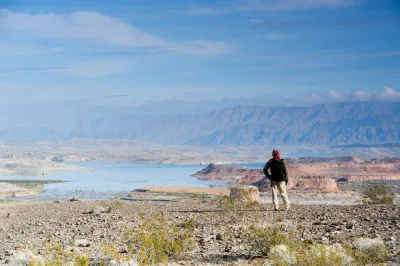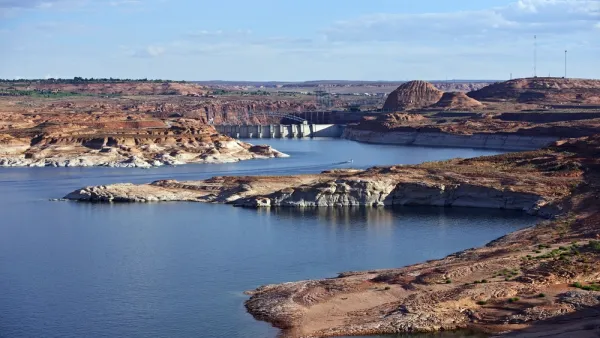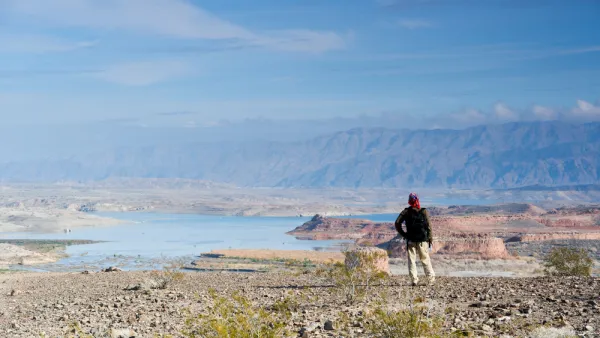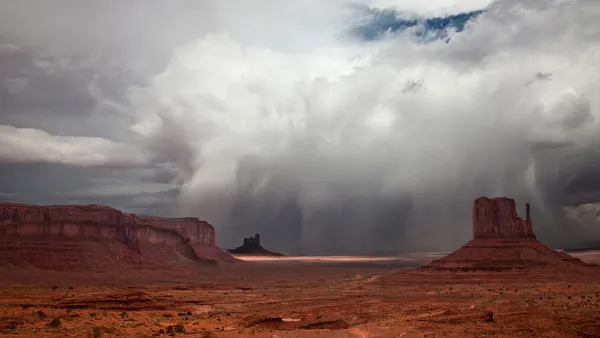The effects of climate change are already cutting deeply into the lifeblood of the U.S. West—the Colorado River.

Ian James reports on the state of the Colorado River after more than two decades of scientists have decided is a "megadrought." The water level of Lake Mead has fallen 130 feet since 2000, and the reservoir is at 39 percent of capacity. The reservoir will soon have less water than any time since the Hoover Dam started filling the lake in the 1930s.
"The latest projections from the federal government show the reservoir will soon fall more feet to cross the trigger point for a shortage in 2022, forcing the largest mandatory water cutbacks yet in Arizona, Nevada and Mexico," reports James The lack of rainfall throughout the West and a meager snowpack in the Rocky Mountains could cause even more severe shortages and water supply cuts the next year, too, according to James.
James has more frightening details to share:
While the Southwest has always cycled through wet and dry periods, some scientists suggest the word "drought" is no longer entirely adequate and that the Colorado River watershed is undergoing “aridification” driven by human-caused warming — a long-term trend of more intense dry spells that’s here for good and will complicate water management for generations to come.
The article also includes coverage of the ongoing efforts to manage the Colorado River as it changes due to climate change, including the Drought Contingency Plan (DCP), signed by seven states along the river in 2019. "Arizona and Nevada agreed to take the first cuts to help prop up Lake Mead, while California agreed to participate at lower shortage levels if the reservoir continues to drop," reports James. Arizona is in line for the largest cuts under the DCP.
The Biden administration also recently announced an interagency working group to support farmers, tribes, and other communities most impacted by water shortages.
Technology is also being deployed in the effort, reports James, including the use of artificial intelligence for scenario planning in the Colorado River Basin, led by Laura Condon, an assistant professor of hydrology and atmospheric sciences at the University of Arizona.
FULL STORY: As a hotter, drier climate grips the Colorado River, water risks grow across the Southwest

Analysis: Cybertruck Fatality Rate Far Exceeds That of Ford Pinto
The Tesla Cybertruck was recalled seven times last year.

National Parks Layoffs Will Cause Communities to Lose Billions
Thousands of essential park workers were laid off this week, just before the busy spring break season.

Retro-silient?: America’s First “Eco-burb,” The Woodlands Turns 50
A master-planned community north of Houston offers lessons on green infrastructure and resilient design, but falls short of its founder’s lofty affordability and walkability goals.

Test News Post 1
This is a summary

Analysis: Cybertruck Fatality Rate Far Exceeds That of Ford Pinto
The Tesla Cybertruck was recalled seven times last year.

Test News Headline 46
Test for the image on the front page.
Urban Design for Planners 1: Software Tools
This six-course series explores essential urban design concepts using open source software and equips planners with the tools they need to participate fully in the urban design process.
Planning for Universal Design
Learn the tools for implementing Universal Design in planning regulations.
EMC Planning Group, Inc.
Planetizen
Planetizen
Mpact (formerly Rail~Volution)
Great Falls Development Authority, Inc.
HUDs Office of Policy Development and Research
NYU Wagner Graduate School of Public Service




























